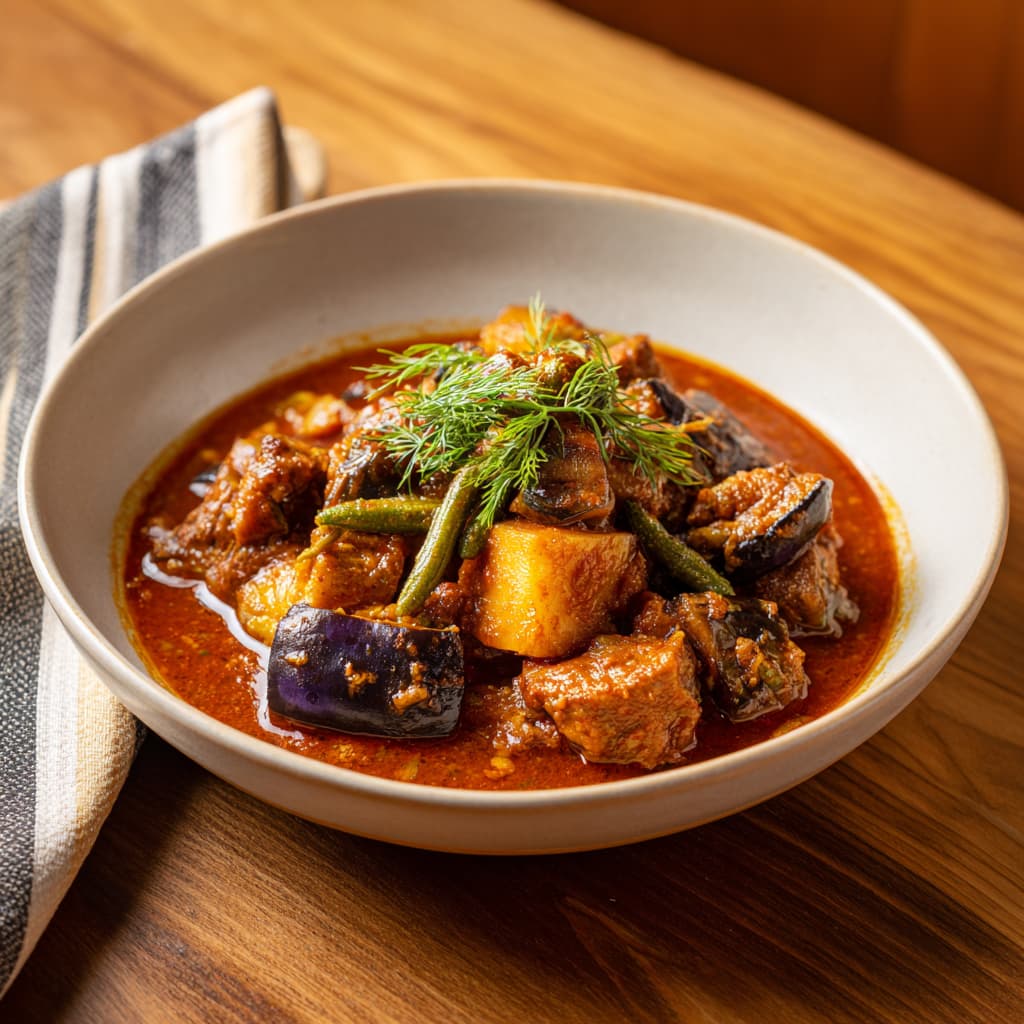Few dishes are as iconic in Filipino cuisine as Kare-Kare. This rich and creamy peanut stew—often made with oxtail, beef, or pork—is the kind of dish that brings families together around the table. Served with vegetables and bagoong (fermented shrimp paste) on the side, it’s a perfect example of how Filipino food balances hearty comfort with bold flavor.
Whether for Sunday family lunch, a fiesta celebration, or a special gathering, Beef Kare-Kare holds a special place in the heart of Filipino households. My first memory of kare-kare was during a town fiesta, where the stew was served in a huge pot, with everyone ladling thick portions over steaming rice. The flavors were warm, nutty, and savory, with bagoong cutting through the richness—an unforgettable taste of home.
This recipe brings the traditional Kare-Kare to your kitchen, using beef and vegetables simmered in a luscious peanut sauce that’s both comforting and impressive.
What Is Kare-Kare?
Kare-Kare is a Filipino stew traditionally made with oxtail, beef tripe, and/or pork hock, slowly simmered in a peanut-based sauce and thickened with ground rice or toasted rice flour. It’s typically served with:
-
Vegetables like eggplant, string beans, banana blossoms, and bok choy
-
Bagoong alamang (fermented shrimp paste), which adds a salty, umami-rich counterpoint
-
Steamed white rice, the perfect vehicle for soaking up the sauce
The dish is believed to have originated from Pampanga, known as the “culinary capital” of the Philippines, though some say its roots trace back to Indian curry influences brought by traders. Whatever its origin, Kare-Kare is now a symbol of Filipino celebratory cooking.
Why You’ll Love This Recipe
Rich and hearty: Comfort food at its best, with beef cooked until tender in a creamy peanut sauce.
-
Authentic taste: Inspired by traditional Filipino methods and ingredients.
-
Customizable: Can be made with oxtail, tripe, or pork, and adapted with available vegetables.
-
Perfect for gatherings: Serves a crowd and tastes even better with company.
Ingredients You’ll Need
For the Beef Stew:
-
2 lbs beef shank or oxtail (or a combination)
-
1 lb beef tripe (optional, for authenticity)
-
1 large onion, quartered
-
6 cups water (more if needed)
-
Salt and black pepper, to taste
For the Kare-Kare Sauce:
-
3 tablespoons annatto oil (or vegetable oil with annatto seeds for color)
-
1 medium onion, chopped
-
4 cloves garlic, minced
-
½ cup smooth peanut butter (unsweetened)
-
2 tablespoons ground toasted rice (see notes below)
-
3–4 cups beef broth (reserved from boiling the beef)
-
1 tablespoon fish sauce (optional, for depth)
-
Salt and pepper, to taste
Vegetables:
-
1 small eggplant, sliced into rounds
-
1 bundle string beans, cut into 3-inch pieces
-
1 bundle bok choy or pechay (Filipino bok choy)
-
1 banana blossom (optional, traditional)
For Serving:
-
Steamed white rice
-
Bagoong alamang (fermented shrimp paste)
Step-by-Step Instructions
Step 1: Prepare the Beef
-
In a large pot, combine beef shank or oxtail, onion, and water.
-
Bring to a boil, then lower heat and simmer for 2–3 hours, or until meat is tender and broth is flavorful.
-
Remove beef and set aside. Strain and reserve the broth.
Tip: Use a pressure cooker to cut cooking time to 45 minutes–1 hour.
Step 2: Toast and Grind Rice
-
In a dry skillet, toast 2 tablespoons uncooked rice until golden brown.
-
Grind into a fine powder using a mortar and pestle or spice grinder.
-
Set aside for thickening the sauce later.
Step 3: Cook the Vegetables
-
Blanch string beans, bok choy, and eggplant in boiling water until just tender.
-
Drain and set aside.
Step 4: Make the Peanut Sauce
-
In a large pan, heat annatto oil.
-
Sauté onion and garlic until softened and fragrant.
-
Stir in peanut butter and mix well.
-
Slowly add 3 cups of reserved beef broth, stirring to create a smooth sauce.
-
Add ground rice and stir until thickened.
-
Season with fish sauce, salt, and pepper. Adjust thickness by adding more broth if needed.
Step 5: Combine and Simmer
-
Add cooked beef into the peanut sauce and simmer for 10–15 minutes to absorb flavor.
-
Arrange vegetables around the stew or add them into the pot.
-
Serve hot with steamed rice and bagoong on the side.
Tips for the Best Kare-Kare
1. Use Bone-In Cuts
Bone-in cuts like shank or oxtail give the broth richness and depth.
2. Balance the Peanut Flavor
Choose unsweetened peanut butter for authenticity. Adjust creaminess by adding more or less.
3. Don’t Skip the Toasted Rice
Ground rice thickens the sauce naturally and adds a nutty undertone. Cornstarch works as a substitute, but rice gives better flavor.
4. Bagoong Is Essential
The salty, umami punch of bagoong balances the richness of the peanut sauce. Always serve it on the side.
5. Make Ahead
Kare-Kare tastes even better the next day as the flavors develop.
Serving Suggestions
Kare-Kare is always served with steamed white rice. For a full Filipino spread, pair it with:
-
Lumpia (spring rolls): Crispy and perfect alongside stew.
-
Grilled or fried fish: To add variety and lighter flavors.
-
Lechon kawali (crispy pork belly): For the ultimate indulgent feast.
-
Atchara (pickled papaya): Adds tang to cut through the richness.
How to Store and Reheat
Storage:
-
Refrigerate leftovers in an airtight container for up to 3 days.
Freezing:
-
Freeze kare-kare without vegetables for up to 2 months. Add fresh vegetables upon reheating.
Reheating:
-
Reheat gently on the stove, adding a splash of broth or water if sauce thickens too much.
Frequently Asked Questions
Can I make kare-kare vegetarian?
Yes! Substitute beef with tofu or mushrooms and use vegetable broth. It’s still delicious with peanut sauce.
Is kare-kare spicy?
No, kare-kare is rich and nutty, not spicy. Heat usually comes from pairing it with bagoong or chili sauce.
What’s a good substitute for banana blossom?
Use napa cabbage or extra bok choy if banana blossom isn’t available.
Can I use peanut butter alone instead of ground peanuts?
Yes, smooth peanut butter is the modern shortcut. For a more traditional flavor, combine it with ground roasted peanuts.
The Cultural Significance of Kare-Kare
Kare-Kare is more than just food—it’s a dish woven into Filipino celebrations. It’s often served during fiestas, holidays, and family gatherings. The effort required (slow cooking, prepping vegetables, balancing flavors) makes it a labor of love, and serving it is seen as a gesture of generosity and hospitality.
Its pairing with bagoong reflects Filipino cuisine’s genius for contrast and balance—sweet and salty, rich and sharp, heavy and refreshing. For many Filipinos abroad, kare-kare represents comfort and nostalgia, a dish that tastes like home.
Why You’ll Love Cooking This Dish
-
It’s hearty and comforting—a stew that warms you inside and out.
-
It’s a taste of tradition—deeply tied to Filipino heritage.
-
It’s versatile—customize meat and vegetables to what’s available.
-
It’s rewarding—a dish that feels special with every spoonful.
Cook Kare-Kare at Home
If you’ve been curious about Filipino food or want to bring a piece of tradition into your kitchen, this Beef Kare-Kare is the perfect recipe to start with. It’s rich, nutty, and deeply comforting—made for sharing with family and friends.
Try it this weekend, serve it with bagoong and rice, and experience why kare-kare is one of the Philippines’ most beloved dishes.
Print
Beef Kare-Kare: A Filipino Peanut Stew Full of Comfort and Tradition
- Total Time: 2 hours 25 minutes
- Yield: 6 servings
Description
Beef Kare-Kare is a classic Filipino stew, rich and comforting, best known for its peanut-based sauce and tender cuts of beef. Traditionally served at fiestas, family gatherings, and Sunday lunches, Kare-Kare is more than just a dish—it’s a celebration of Filipino culture and togetherness. The savory-sweet peanut sauce pairs beautifully with oxtail, beef shank, or short ribs, and the dish is typically enjoyed with bagoong (fermented shrimp paste) on the side, which adds a salty punch that balances the richness. Served with rice, it’s a hearty, satisfying meal that embodies the essence of Filipino comfort food.
Ingredients
-
2 lbs (900 g) beef shank, oxtail, or short ribs (or a mix)
-
1 onion, quartered
-
5 cups water
-
2 tbsp vegetable oil
-
4 garlic cloves, minced
-
1 onion, finely chopped
-
1/2 cup peanut butter (smooth or chunky, depending on preference)
-
1/4 cup ground toasted rice (for thickening)
-
1/4 cup annatto seeds (soaked in warm water) or 1 tbsp annatto powder
-
1 eggplant, sliced into rounds
-
1 bunch bok choy or pechay, trimmed
-
1 banana heart (optional, traditional ingredient), sliced
-
12–15 long green beans, trimmed
-
Salt and black pepper, to taste
-
Bagoong (fermented shrimp paste), for serving
Instructions
ctions
-
Place beef shank and/or oxtail in a large pot with onion and water. Bring to a boil, then reduce heat and simmer for 1 ½–2 hours until meat is tender. Skim off impurities while cooking. Remove meat and set aside, reserving the broth.
-
In a large pan, heat oil over medium heat. Sauté garlic and chopped onion until softened.
-
Stir in peanut butter, ground toasted rice, and annatto water (or powder). Add 4 cups of reserved beef broth, stirring until smooth and thickened. Simmer gently for 10 minutes.
-
Return the cooked beef to the pot and coat with the sauce. Simmer for another 15–20 minutes to allow flavors to meld.
-
Meanwhile, blanch vegetables (eggplant, bok choy, banana heart, and green beans) in boiling water for 2–3 minutes until just tender but still vibrant. Drain and set aside.
-
Arrange vegetables around the beef stew when serving, or serve on the side for guests to mix in.
-
Enjoy hot with steamed white rice and bagoong on the side.
- Prep Time: 2 hours
- Cook Time: 25 minutes





